Skoura Oasis is a beautiful and peaceful spot in southern Morocco. Located between the High Atlas Mountains and the edge of the Sahara Desert, it’s a place where nature and history come together. The oasis is known for its wide palm groves, traditional farming, and old mud-brick buildings called Kasbahs.
Skoura is special because of its balance between the past and the present. You’ll find farmers growing crops using age-old methods while surrounded by the rich cultural history of Morocco. Visitors are often surprised by how green and lively the area is, especially since it sits near the desert.
People come to Skoura to enjoy its natural beauty, explore the historic fortresses, and experience the warm hospitality of the local Berber people. The oasis is also famous for its eco-friendly tourism, which helps protect both the environment and its cultural heritage.
The Lush Palm Groves of Skoura – A Natural Marvel
The palm groves of Skoura are like a green sea in the middle of the desert. These tall, graceful trees make Skoura stand out from the dry land around it. Palm groves have been part of life in this oasis for hundreds of years. The trees not only offer shade but also play an important role in the farming that happens here.
Farmers in Skoura rely on date palms to grow crops such as dates, olives, and almonds. The dates from these trees are a valuable food source and are sold to help support the community. Beneath the palm trees, farmers grow vegetables and grains. This layered farming method makes sure that every bit of land is used wisely.
A special irrigation system called “khettaras” helps water the crops. These ancient underground channels bring water from the Atlas Mountains to the oasis. This system is important because it helps conserve water in this dry region. Without the palm groves and the careful use of water, Skoura would not be the lush and productive place it is today.
Best Places to Visit in Skoura Oasis
Kasbah Amridil
Kasbah Amridil is one of the most iconic landmarks in Skoura Oasis and is considered one of the finest examples of traditional Moroccan architecture. This well-preserved mud-brick fortress dates back to the 17th century and offers visitors a glimpse into Morocco’s rich cultural and architectural heritage. The kasbah has been featured in several films and continues to impress visitors with its intricate carvings, large towers, and spacious courtyards. Walking through its narrow hallways, you can see tools and objects used in traditional Moroccan life, making it not only a historical site but also a living museum. Guided tours are available, allowing visitors to learn more about the kasbah’s significance and the way people lived here centuries ago.
Skoura Palm Groves (Palmeraie)
The Skoura Palmeraie, or palm groves, stretch across a vast area, offering a green, lush landscape in the middle of the arid surroundings. These palm groves are the heart of the oasis and have been supporting the local agricultural community for generations. Walking or cycling through the groves, you’ll come across traditional farms where dates, olives, and almonds are grown under the shade of tall palm trees. The palm groves also serve as a beautiful backdrop for those looking to escape the hustle of city life and enjoy nature’s peace. The groves are kept alive by the ancient Khettaras irrigation system, which channels water from the nearby Atlas Mountains to ensure the land remains fertile. It’s an ideal place to appreciate Skoura’s natural beauty and learn about its agricultural importance.
Kasbah Ait Ben Moro
Another must-visit fortress in Skoura is Kasbah Ait Ben Moro. Overlooking the palm groves, this kasbah has been carefully restored to preserve its authentic charm. Visitors can stay overnight or tour the kasbah to learn about its history and enjoy stunning views of the surrounding oasis. The structure is a fine example of the fortified homes that were built in this region to protect families from invasions and natural elements. The kasbah’s large corner towers and thick walls are characteristic of the defensive architecture used throughout the region. Whether staying as a guest or visiting for a few hours, Kasbah Ait Ben Moro offers a beautiful, immersive experience of traditional Moroccan life.

Dades Valley
Located a short distance from Skoura, the Dades Valley is known for its dramatic landscapes and scenic roads. The valley features towering red rock formations, lush green valleys, and Berber villages that dot the hillsides. The Dades River runs through the valley, providing water for the villages and farms along its banks. Visitors can explore the valley by car, bike, or on foot, with plenty of opportunities for photography and adventure. The winding roads through the Gorges du Dades offer spectacular views and are a popular route for those heading to the Sahara Desert. It’s an excellent day trip from Skoura, providing a contrast between the oasis and the rugged mountain terrain.
Atlas Mountains
Skoura’s proximity to the High Atlas Mountains makes it an ideal starting point for exploring this vast mountain range. The mountains are known for their rugged beauty and are a popular destination for hiking, trekking, and mountain biking. The melting snow from the Atlas Mountains helps feed the irrigation systems in Skoura, sustaining the palm groves and farmland. Visitors can take guided hikes into the mountains to explore the traditional Berber villages that dot the landscape. These villages offer a unique glimpse into life in rural Morocco, where farming and hospitality are central to the community. The Atlas Mountains also provide a cooler climate, offering a refreshing break from the heat of the oasis.
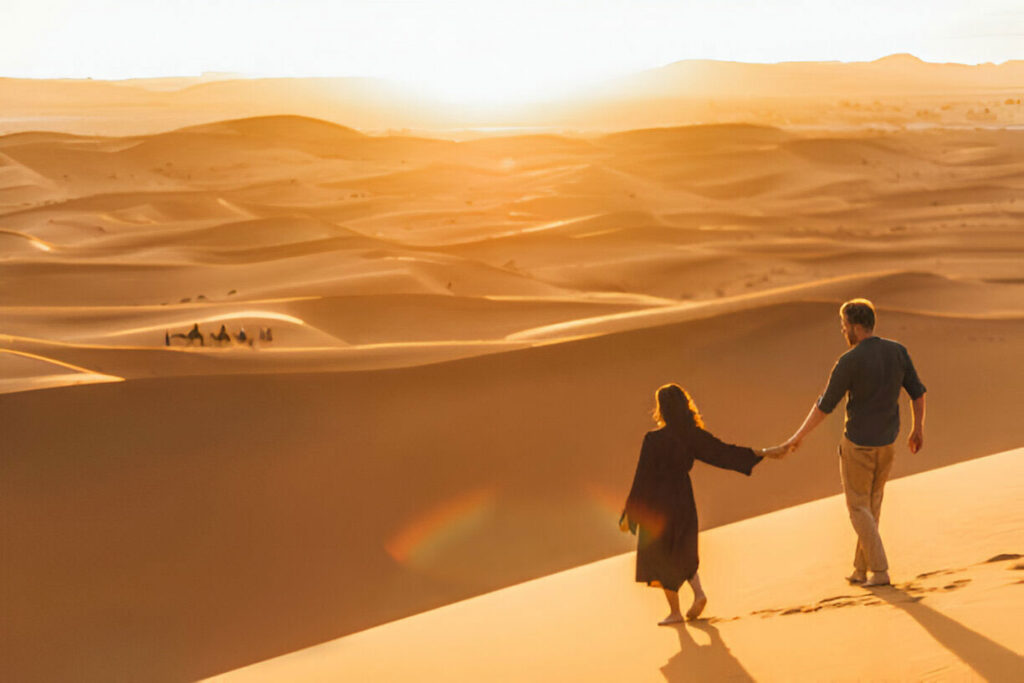
Sahara Desert Excursions
Just south of Skoura lies the vast Sahara Desert, and many visitors use Skoura as a base for organizing desert excursions. A trip into the desert offers a completely different experience, with its endless dunes, starry skies, and camel rides. Visitors can arrange for a night in a traditional desert camp, where they can enjoy Moroccan meals around a campfire, listen to Berber music, and gaze at the stars in one of the clearest night skies in the world. The transition from the green palm groves of Skoura to the golden sands of the Sahara is a memorable experience for any traveler.
Khettaras Irrigation System
One of the most fascinating aspects of Skoura’s agricultural success is the Khettaras irrigation system, an ancient network of underground channels that transport water from the Atlas Mountains to the oasis. These channels have been used for centuries to manage water in this arid region. Visitors to Skoura can explore some of these channels and learn about the engineering that has kept the oasis green for so long. Understanding this system gives insight into the hard work and ingenuity of the local communities who have lived in harmony with their environment for generations.
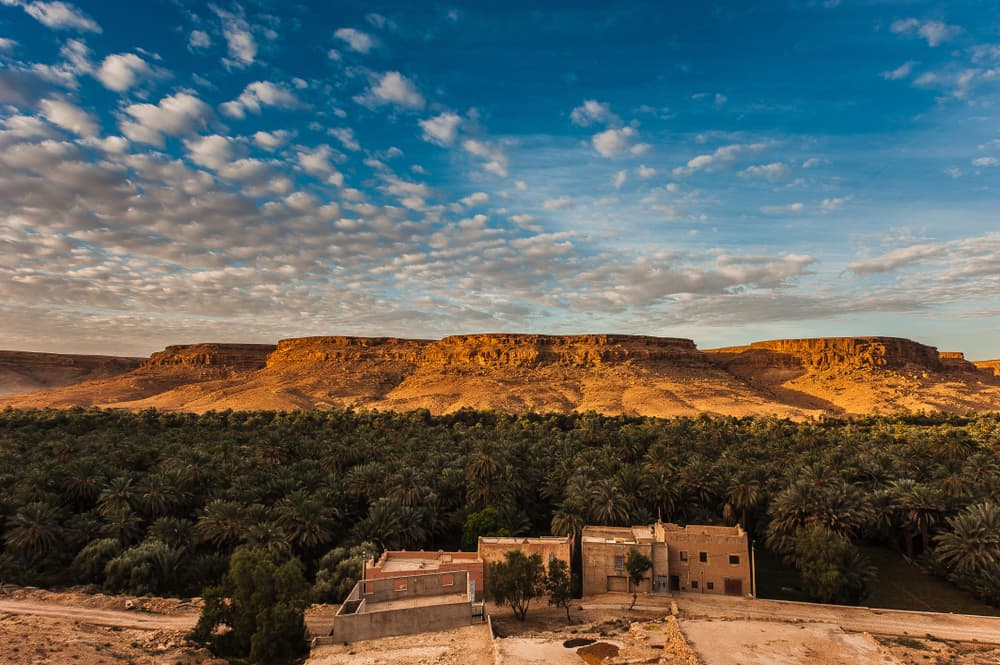
Draa Valley
Not far from Skoura, the Draa Valley is a lush, fertile region famous for its sprawling date palm plantations. The Draa River runs through the valley, making it an important agricultural hub in the Draa-Tafilalet region. Visiting the Draa Valley allows you to see more of Morocco’s traditional farming methods and explore ancient Kasbahs similar to those found in Skoura. The valley is also a popular stop for travelers on their way to the Sahara Desert, offering both historical and natural beauty.
Local Markets
A visit to Skoura’s local markets is a great way to experience the daily life of the people who live in the oasis. The markets are filled with fresh produce, handmade crafts, and traditional Moroccan goods. You can find beautiful Berber textiles, pottery, and woven baskets alongside stalls selling dates, almonds, and olives grown in the surrounding groves. These markets are lively, colorful, and full of warm hospitality, providing a chance to connect with the locals and support their livelihoods.
Eco-Friendly Lodges and Riads
Skoura is also home to several eco-friendly accommodations that emphasize sustainability and respect for the environment. Places like Dar Ahlam and Sawadi Eco-Lodge offer visitors a chance to experience the beauty of the oasis while minimizing their environmental footprint. These lodges use solar energy, grow their organic produce, and focus on water conservation. Staying in one of these eco-lodges allows you to enjoy modern comforts while being mindful of the fragile environment of the oasis. It’s an excellent way to support local businesses that are committed to preserving Skoura’s natural and cultural heritage.
Kasbahs and Mud-Brick Fortresses – Exploring the Historical Heritage of Skoura
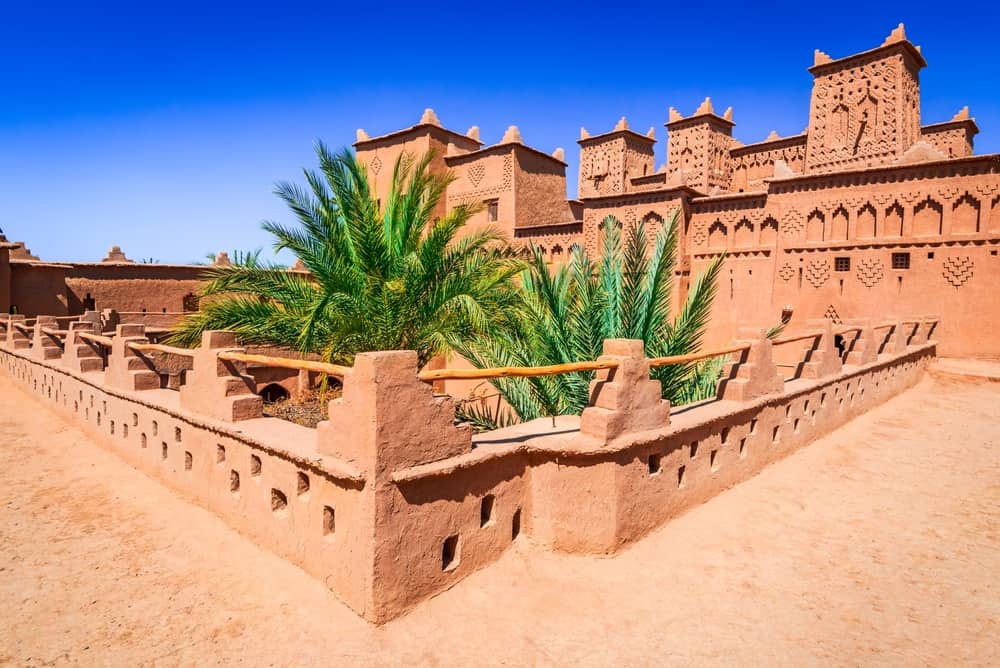
The Kasbahs of Skoura are like stepping back in time. These tall, mud-brick fortresses were built centuries ago to protect families and villages. One of the most famous Kasbahs is Kasbah Amridil, which is known for its impressive size and unique architecture. It has been carefully preserved and is open to visitors who want to learn about life in ancient Morocco.
Kasbah Amridil is not the only fortress in Skoura. Many other smaller Kasbahs dot the landscape, each with its own story. These Kasbahs were built using a special kind of brick made from mud and straw. The thick walls help keep the buildings cool in the hot desert sun.
Walking through a Kasbah feels like walking through history. The narrow passageways, tall towers, and intricate carvings show how skilled the builders were. These structures are a big part of what makes Skoura so special. They remind visitors of the rich cultural history that has shaped the oasis.
Cultural Significance of Skoura Oasis
Skoura is more than just a pretty place; it’s a center of rich Moroccan culture. The local people, many of whom are Berber, have lived here for generations. Their traditions are still alive today, from the way they farm to the way they celebrate important events.
One of the main events in Skoura is the Date Festival, which takes place each year. During the festival, farmers bring their best dates to sell, and there is music, dancing, and food. It’s a time for the community to come together and celebrate the harvest.
In Skoura, you can also find traditional crafts like pottery and weaving. These handmade items are made using techniques passed down through families. Visiting Skoura is a chance to see the deep connection the people have to their land and history.
Biodiversity and Wildlife in Skoura Oasis
The oasis is home to a surprising variety of plants and animals. Thanks to the palm groves and farmland, many species can live here even though it’s close to the desert. You can see birds like eagles and falcons flying above the trees. In the groves and gardens, smaller animals like lizards and rabbits find shelter.
The plants in Skoura are just as important as the animals. Besides the palm trees, you’ll find other plants like olive and fig trees. These plants not only feed the local people but also help keep the soil healthy.
To protect the wildlife, the people of Skoura work hard to keep their land clean and natural. They understand that without a healthy ecosystem, the oasis would not survive. Tourism also plays a part in protecting wildlife, as eco-friendly practices are encouraged.
Skoura’s Proximity to Iconic Moroccan Landscapes
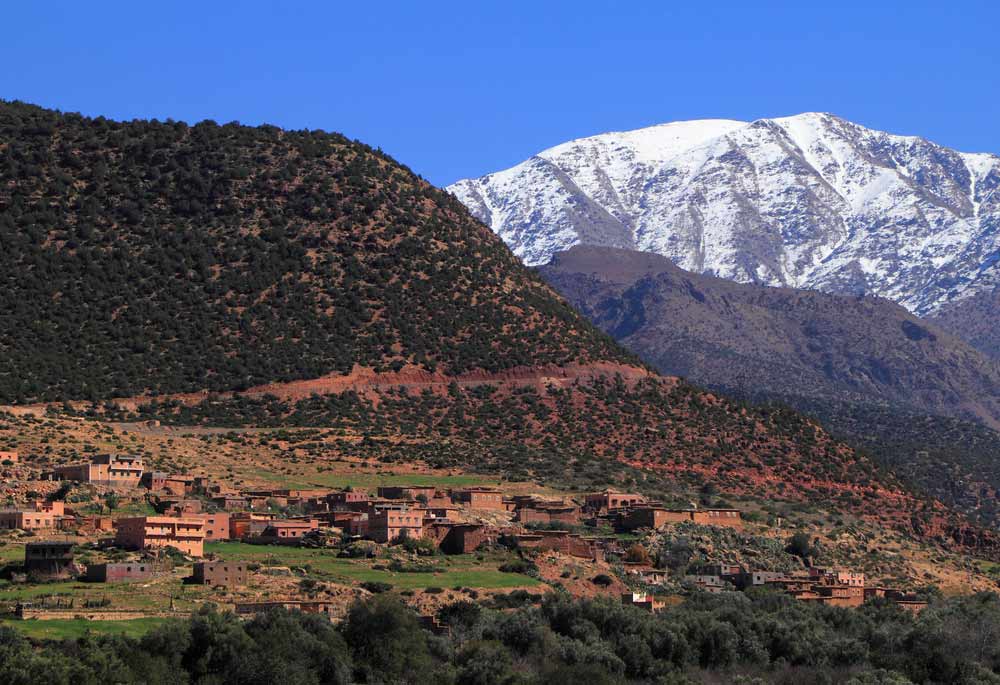
Skoura is a great place to visit because it’s close to some of Morocco’s most famous natural sites. To the north, you can see the High Atlas Mountains, where adventurous travelers can go hiking or camping. These mountains are not only beautiful but also provide water to the oasis through melting snow.
To the south, you find the Sahara Desert. From Skoura, visitors can arrange trips to the Sahara, where they can ride camels or spend a night under the stars. Skoura is the perfect base for exploring both the mountains and the desert.
Because Skoura is close to places like Ait Benhaddou, a famous UNESCO World Heritage site, and the Dades Valley, it’s easy for visitors to see many of Morocco’s best sights while staying in the oasis.
The Photogenic Landscapes of Skoura – A Paradise for Photographers
For photographers, Skoura is a dream come true. The mix of lush greenery, ancient Kasbahs, and the distant mountains creates a stunning backdrop. The palm groves look especially beautiful during sunrise and sunset when the light turns the sky into shades of orange and pink.
The Kasbahs, like Kasbah Amridil, are also popular spots for taking photos. Their tall, mud-brick walls and corner towers stand out against the green fields and blue sky. Visitors often spend hours capturing the beauty of these historical structures.
Even the desert areas around Skoura offer great photography opportunities. The vast open spaces and shifting dunes of the Sahara Desert create dramatic and unique shots. No matter where you look in Skoura, there’s something beautiful to capture with your camera.
Eco-Friendly Tourism in Skoura – Sustainable Travel Practices
Skoura has become a popular destination for travelers who care about the environment. Eco-friendly tourism is growing in the oasis, with many hotels and lodges focusing on sustainability. These accommodations use solar energy, recycle water, and grow organic food for their guests.
By choosing eco-friendly travel options, visitors can help protect the natural beauty of Skoura. Many local guides also offer tours that teach visitors about the importance of conservation and water management in the oasis. These tours are a great way to learn about how people live in harmony with nature.
Eco-tourism not only helps the environment but also supports the local economy. It allows the people of Skoura to make a living while preserving their traditions and natural resources.
Traditional Agriculture in Skoura – A Living Heritage
Farming is a way of life in Skoura. For centuries, the people have used the land to grow food and support their families. The palm groves are an important part of this farming system. Underneath the trees, farmers grow crops like dates, wheat, and vegetables.
Skoura’s farmers use a traditional irrigation system called the khettaras, which brings water from the mountains to the fields. This ancient system helps conserve water, making it possible to farm in a dry region.
The connection between the people and the land is strong. Many farming techniques have been passed down through generations, and visiting Skoura is a chance to see these methods in action. Tourists can even take part in farming activities, learning how crops are grown and harvested.
Skoura’s Cultural and Environmental Future
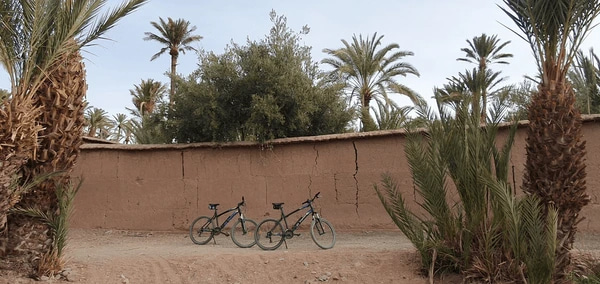
As Skoura grows in popularity, it faces challenges in preserving its natural beauty and cultural heritage. Development and desertification are two big issues. The people of Skoura are working hard to protect their oasis by promoting eco-friendly tourism and sustainable farming.
Conservation projects, such as planting more palm trees and using water-saving techniques, help fight desertification. The local community also plays a big role in protecting the Kasbahs and other cultural landmarks. By restoring these historic buildings, they ensure that future generations can learn from the past.
The future of Skoura depends on finding a balance between tourism, culture, and nature. With the right care, this oasis can continue to be a place where visitors can experience the best of Morocco’s history and environment.
Conclusion
Skoura Oasis is a truly remarkable destination, blending natural beauty with rich history and culture. The palm groves, ancient Kasbahs, and traditional farming methods give the oasis a timeless quality, making it a perfect place for travelers seeking both relaxation and adventure. Its unique location between the Atlas Mountains and the Sahara Desert adds to its charm, offering a landscape that changes from lush greenery to arid desert.
As more people discover Skoura, eco-friendly tourism is playing an important role in protecting its delicate environment and cultural heritage. By choosing sustainable travel options, visitors can help conserve the water, land, and ancient structures that make Skoura so special. The local community is deeply connected to the land, and their efforts to balance tradition with modernity are key to ensuring that future generations can enjoy this beautiful oasis.
In the years to come, Skoura will continue to grow as a top destination for eco-conscious travelers. Its combination of natural wonders, cultural significance, and sustainable tourism make it an ideal place for anyone looking to experience the real Morocco. Whether you’re drawn to the peaceful palm groves or the historic Kasbahs, a visit to Skoura Oasis is an unforgettable journey into the heart of Moroccan life.
FAQs
How do I get to Skoura Oasis?
Skoura is accessible by car or bus from major Moroccan cities like Marrakech, Fez, and Ouarzazate. The nearest airport is in Ouarzazate, about 30 minutes away.
What is the best time to visit Skoura Oasis?
The best time to visit is during the spring (March to May) or fall (September to November) when temperatures are milder.
Are there any guided tours available in Skoura?
Yes, local guides offer tours of the Kasbahs, palm groves, and surrounding areas. Some tours also focus on eco-tourism and traditional agriculture.
Can I stay overnight in Skoura?
Yes, there are several accommodations ranging from eco-lodges to traditional riads that offer overnight stays.
Is Skoura a good destination for families?
Skoura is family-friendly, offering a peaceful environment and educational experiences related to nature, history, and culture.
